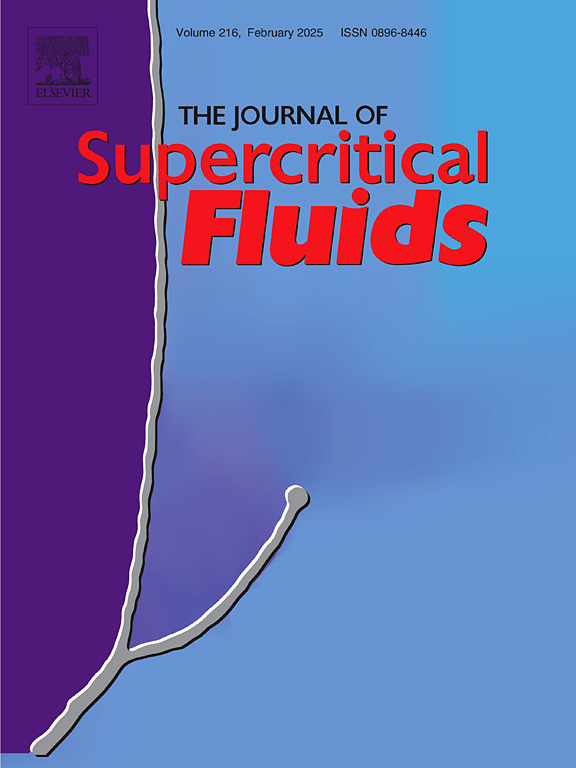Observations and analysis of near-critical fuel injection
IF 3.4
3区 工程技术
Q2 CHEMISTRY, PHYSICAL
引用次数: 0
Abstract
Results from a study of n-heptane jets injected into a nitrogen environment under supercritical pressures with respect to n-heptane are presented. The temperature of the injected jet varies from supercritical to subcritical values (with respect to the n-heptane critical temperature) while the ambient environment is maintained at temperatures above the critical temperature of n-heptane. Three types of jets are observed and described: (1) subcritical, where the liquid/gas interface persists until complete evaporation of the liquid phase (2) supercritical, where there is no sharp interface between the injected jet and the ambient gas, and (3) transcritical, where distinct liquid/gas phase interface exists at injection but disappears before complete evaporation of the liquid. The subcritical and transcritical jets exhibit Rayleigh-Plateau instability where the jet breaks up into droplets. For subcritical jets, the droplets maintain their sharp interface whereas for the transcritical case the droplets transition from evaporative mixing to diffusive mixing with the surrounding fluid. The experiments are conducted under microgravity conditions at the Zero-Gravity Facility at NASA Glenn Research Center to minimize effects of buoyancy. To interpret these observations, the evolution of a transitioning droplet is modeled with a Regularized Interface Method that can describe both subcritical and supercritical processes as well as transcritical dynamics. Model predictions of critical transition are compared with experimental results and show good agreement.
近临界燃油喷射的观察与分析
本文介绍了超临界氮气环境下正庚烷射流的研究结果。注入射流的温度从超临界到亚临界值(相对于正庚烷的临界温度)变化,而周围环境的温度保持在正庚烷的临界温度以上。观察和描述了三种类型的射流:(1)亚临界,其中液/气界面一直持续到液相完全蒸发;(2)超临界,其中注入的射流与周围气体之间没有明显的界面;(3)跨临界,在注入时存在明显的液/气界面,但在液体完全蒸发之前消失。亚临界和跨临界射流表现出瑞利-高原不稳定性,射流破裂成液滴。对于亚临界射流,液滴保持其尖锐的界面,而对于跨临界射流,液滴与周围流体从蒸发混合转变为扩散混合。这些实验是在美国宇航局格伦研究中心的零重力设施的微重力条件下进行的,以尽量减少浮力的影响。为了解释这些观察结果,用正则化界面方法对过渡液滴的演化进行了建模,该方法可以描述亚临界和超临界过程以及跨临界动力学。对临界跃迁的模型预测结果与实验结果进行了比较,结果吻合较好。
本文章由计算机程序翻译,如有差异,请以英文原文为准。
求助全文
约1分钟内获得全文
求助全文
来源期刊

Journal of Supercritical Fluids
工程技术-工程:化工
CiteScore
7.60
自引率
10.30%
发文量
236
审稿时长
56 days
期刊介绍:
The Journal of Supercritical Fluids is an international journal devoted to the fundamental and applied aspects of supercritical fluids and processes. Its aim is to provide a focused platform for academic and industrial researchers to report their findings and to have ready access to the advances in this rapidly growing field. Its coverage is multidisciplinary and includes both basic and applied topics.
Thermodynamics and phase equilibria, reaction kinetics and rate processes, thermal and transport properties, and all topics related to processing such as separations (extraction, fractionation, purification, chromatography) nucleation and impregnation are within the scope. Accounts of specific engineering applications such as those encountered in food, fuel, natural products, minerals, pharmaceuticals and polymer industries are included. Topics related to high pressure equipment design, analytical techniques, sensors, and process control methodologies are also within the scope of the journal.
 求助内容:
求助内容: 应助结果提醒方式:
应助结果提醒方式:


